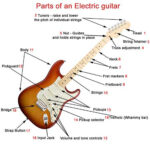Starting your guitar journey is an exciting endeavor, but it’s common to encounter initial hurdles, especially concerning hand and thumb positioning. If you’re struggling with holding your thumb correctly, rest assured, it’s a completely normal experience. Unlike many everyday activities, playing the guitar requires our hands to adopt unique positions that our muscles aren’t initially accustomed to. These early challenges often stem from a lack of developed strength and dexterity in the specific muscles needed for guitar playing.
Think of your brain as your personal trainer for your fingers. Just like a gym trainer guides your movements until you build sufficient strength and coordination, your brain plays the same role in Guitar Practice. It meticulously monitors your hand movements until you develop the necessary muscle memory and dexterity to execute them smoothly and consistently.
Conditioning your body for any new physical activity, like playing guitar, takes time and dedicated practice. The training regimen for tennis differs vastly from that of a powerlifter. Similarly, our hands are trained for everyday tasks. When we introduce guitar playing, we need to retrain and condition those muscles to effectively perform this new, intricate activity.
As we delve deeper, you’ll realize that many challenges you face with hand positioning while playing guitar often originate from improper thumb placement. Correcting your thumb position is a foundational step in effective guitar practice and overall playing technique.
Achieving Proper Palm Position for Enhanced Guitar Practice
When practicing guitar techniques, particularly exercises aimed at finger dexterity, maintaining a flat palm is crucial. Many beginners inadvertently practice with their palm at an angle. However, a flat palm is essential as it facilitates a naturally rounded pinky finger position, which is vital for applying optimal pressure on the strings.
Consider the act of holding a heavy object at arm’s length. Whether you’re a seasoned bodybuilder or simply carrying groceries, you’ll instinctively curl your arm to bring the weight closer to your body. This makes it significantly easier to manage and control the load. Guitar strings possess tension, somewhat akin to lifting weights with your fingers. If we don’t maintain a rounded pinky finger by keeping our palm flat, it’s like trying to hold that heavy grocery bag at full arm’s length. It becomes harder to apply consistent pressure, our muscles fatigue quickly, and we lose dexterity. A flat palm allows the pinky finger to naturally curve, bringing its tip closer to the knuckle. This drastically improves leverage, making it easier to apply proper pressure to the strings and significantly enhancing finger dexterity during guitar practice.
In addition to palm flatness, visualize bringing the knuckles at the base of your fingers slightly forward, ideally in line with or just ahead of the fretboard. This encourages the use of your fingertips for fretting and improves your reach across the fretboard. As you transition from the lower thicker strings (like the low E) to the higher thinner strings (like the high E), ensure a straight line forms between the second knuckles of your fingers and your elbow. This alignment is crucial to prevent repetitive strain injuries (RSI) by avoiding nerve constriction in your wrist. While initial incorrect hand positions are unlikely to cause serious harm, consult a physiotherapist if you experience persistent wrist pain. Some muscle fatigue is expected as your hands adapt to new exercises during guitar practice. Remember, muscle fatigue after practice is often a sign that you’re challenging yourself and making progress!
Maximizing Your Mental Bandwidth During Guitar Practice
A key concept for effective guitar practice is understanding mental bandwidth. This refers to the limited amount of focused attention we can allocate while practicing. If we over-focus on one aspect of our playing, we risk neglecting other important elements. As we increase the number of things we consciously try to control during practice, the attention available for each element diminishes. Furthermore, attempting to play faster reduces our overall available focus.
Effective guitar practice involves consciously managing this mental bandwidth. Instead of trying to perfect everything at once, break down your practice sessions into focused segments. Concentrate on specific techniques, like thumb position or palm flatness, in isolation before integrating them into more complex playing. By being mindful of your mental bandwidth and practicing deliberately, you’ll optimize your learning and progress in your guitar journey.

